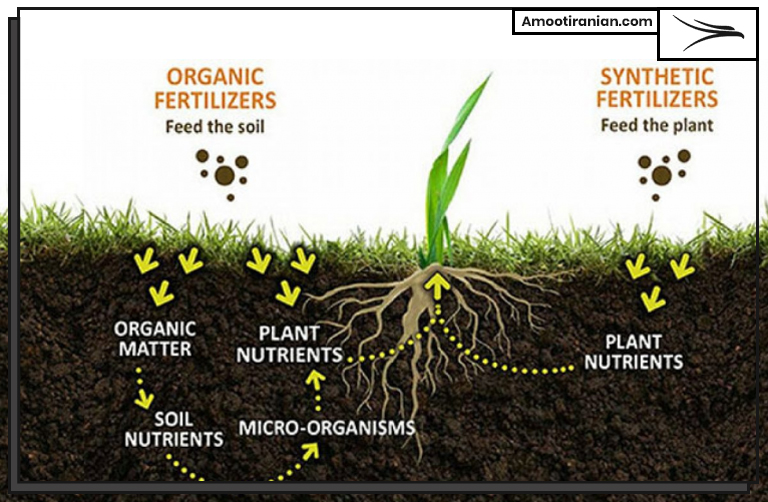.
.
Fertilizer is a substance, usually in the form of granules or powders,
It is added to soil to provide nutrients essential for plant growth.
These nutrients include:
1.nitrogen
2. phosphorus
3. potassium

.
What is fertilizer?
Fertilizer is a broad term used to describe any substance or mixture of substances added to soil or plant tissues to provide nutrients essential for plant growth.
.

..
These nutrients are typically divided into three categories:
- primary macronutrients
- secondary macronutrients
- micronutrients
.

.
Three Categories of the Required Nutrients for the Plants
| Macronutrient | Symbol | Function |
| Primary macronutrients | ||
| Nitrogen | N | A component of amino acids and nucleic acids. . It is essential for plant growth and protein synthesis. . |
| Phosphorus | P | Essential for: 1. energy transfer 2. cell division 3. root growth . |
| Potassium | K | Regulates water balance and other physiological processes. . It is essential for overall plant health. . |
| Secondary macronutrients | ||
| Calcium | Ca | Essential for: 1. cell wall structure 2. overall plant development . |
| Magnesium | Mg | A component of chlorophyll . It is essential for: 1. photosynthesis 2. overall plant health . |
| Sulfur | S | Essential for: 1. the synthesis of certain amino acids and proteins 2. overall plant health . |
| Micronutrients | ||
| Iron | Fe | Essential for: 1. chlorophyll synthesis 2. overall plant health . |
| Zinc | Zn | Essential for: 1. enzyme function 2. overall plant development . |
| Copper | Cu | Essential for: 1. photosynthesis 2. overall plant health . |
| Manganese | Mn | Essential for: 1. enzyme function 2. overall plant health . |
| Boron | B | Essential for: 1. cell wall formation 2. overall plant development . |
| Molybdenum | Mo | Essential for: 1. nitrogen metabolism 2. overall plant health . |
| Chlorine | Cl | Regulates water balance and overall plant health . |
.
Note that this table is not exhaustive and there may be other micronutrients that are required in trace amounts by some plants.
.
How Many Types of Fertilizers Do We Have?
There are two main types of fertilizers:
- organic
- inorganic (also known as synthetic or chemical fertilizers)
.
Types of Fertilizers
| Fertilizer Type | Description |
| Organic | Derived from natural sources such as: 1. plant 2. animal matter 3. compost 4. manure 5. other organic materials |
| Nutrients are released slowly over time as organic matter decomposes | |
| Improves soil structure and fertility | |
| Enhances microbial activity and soil health | |
| Typically has lower nutrient concentration compared to inorganic fertilizers | |
| Inorganic | Synthetically manufactured using chemicals and minerals |
| Nutrients are readily available for immediate plant uptake | |
| Can be customized to provide specific nutrient ratios | |
| Can be formulated as: 1. granules 2. pellets 3. liquids for easy application | |
| May be more prone to leaching and environmental pollution if not used properly | |
| Can be more cost-effective than organic fertilizers due to higher nutrient concentration |
.
Organic fertilizers are derived from natural sources such as animal manure, compost, bone meal, and blood meal.
These fertilizers release nutrients slowly over time as they decompose, providing a more sustainable source of nutrients for plants.
Organic fertilizers also help improve soil structure, increase water-holding capacity, and promote beneficial microbial activity in the soil.
.

.
Inorganic fertilizers, on the other hand, are manufactured chemically and are often formulated to provide a specific balance of nutrients to plants.
Inorganic fertilizers typically release nutrients quickly and are readily available to plants, but they can also leach into groundwater and contribute to environmental pollution if not used properly.
Inorganic fertilizers can be further classified into nitrogen, phosphorus, and potassium fertilizers, as well as micronutrient fertilizers that provide trace elements such as iron, zinc, and copper.
.

.
Fertilizer’s Applications
.
| Application | Description |
| Promoting plant growth | Fertilizers provide essential nutrients that plants need to grow and thrive, such as: 1. nitrogen 2. phosphorus 3. potassium Nitrogen is necessary for leaf and stem growth. Phosphorus promotes root growth and flower development. Potassium helps regulate water balance and other physiological processes. . |
| Improving crop yields | By providing plants with the nutrients they need to grow and produce, fertilizers can help improve crop yields and quality. . In areas where soil is naturally low in nutrients or where crops have been grown repeatedly without proper nutrient replenishment, fertilizers can be essential for maintaining high yields. . |
| Correcting nutrient deficiencies | When plants show signs of nutrient deficiencies, such as yellowing leaves, stunted growth, or poor fruit development, fertilizers can be used to correct the problem. . Soil testing can help identify which nutrients are lacking, and fertilizers can be applied to provide those specific nutrients. . |
| Supporting specific plant needs | Different plants have different nutrient requirements, and fertilizers can be tailored to meet those needs. . For example, citrus trees may require higher levels of nitrogen and micronutrients, while vegetables may benefit from additional phosphorus and potassium. . Fertilizers can be formulated to provide the specific balance of nutrients that different plants need. . |
| Environmental considerations | . Fertilizers can have environmental impacts if not used properly, such as contributing to water pollution through runoff or leaching. . Proper application rates and timing can help minimize these impacts. . Some fertilizers, such as organic fertilizers, can also help improve soil health and reduce erosion. . Additionally, fertilizers can be used as part of sustainable agriculture practices, such as using cover crops or crop rotations to maintain soil fertility. . |
| Industrial applications | Fertilizers are also used in non-agricultural applications, such as in the production of industrial chemicals or in mining and mineral processing. . For example, ammonium nitrate is a common fertilizer that is also used as an explosive in mining operations. . |
.

.
Note that this table provides a general overview of some common applications of fertilizers, and there may be variations depending on
- specific crops
- soil types
- regional practices
.
Additionally, the use of fertilizers should be balanced with other practices, such as crop rotation and integrated pest management, to promote sustainable agriculture.
.
What Are the Advantages of Fertilizers?
.

.
Advantages of Fertilizers for the Plants
| Advantage | Description |
| Improved crop yields and quality | Fertilizers provide essential nutrients that plants need to grow and produce, which can help increase crop yields and improve quality. . In areas where soil is naturally low in nutrients or where crops have been grown repeatedly without proper nutrient replenishment, fertilizers can be essential for maintaining high yields. . |
| Better use of land resources | By providing plants with the nutrients they need, fertilizers can help make better use of limited land resources. . With proper nutrient management, farmers can produce more food on less land, which can help preserve natural ecosystems and reduce pressure on wild lands. . |
| Tailored to specific needs | Different crops and soils have different nutrient requirements, and fertilizers can be tailored to meet those needs. . Fertilizers can be formulated to provide the specific balance of nutrients that different crops need, which can help optimize growth and production. . |
| Increased food security | Fertilizers can help increase food production, which can contribute to greater food security. . With a growing global population and changing dietary patterns, the demand for food is expected to continue to rise, and fertilizers can help meet that demand by improving crop yields and quality. . |
| Enhanced soil health | Fertilizers can help improve soil health by promoting microbial activity, enhancing nutrient cycling, and increasing organic matter content. . By improving soil health, fertilizers can help reduce erosion, increase water holding capacity, and improve the overall productivity of agricultural land. . |
| Improved economic outcomes | By increasing crop yields and quality, fertilizers can help improve economic outcomes for farmers and rural communities. . With higher production, farmers can potentially earn more income, which can contribute to greater economic growth and development. . Additionally, the use of fertilizers can support other economic activities, such as agricultural input supply chains and food processing industries. . |
.
What Are the Disadvantages of Inorganic Fertilizers?
.

.
Potential Disadvantages of Inorganic Fertilizers
| Disadvantage | Description |
| Soil degradation | Overuse of inorganic fertilizers can lead to soil degradation, which can: 1. reduce soil fertility 2. cause nutrient imbalances 3. damage soil structure and function . This can lead to long-term problems for agriculture and the environment. . |
| Environmental pollution | Excess inorganic fertilizers can: 1. leach into groundwater 2. runoff into nearby waterways 3. leading to environmental pollution 4. harm to aquatic ecosystems . This can impact not only the environment but also human health and other organisms that rely on these ecosystems. |
| Health risks | Inorganic fertilizers may contain chemicals that can be harmful to human health if not used properly. . This can lead to skin and respiratory problems, as well as other health issues. Prolonged exposure to these chemicals can be particularly hazardous. . |
| Decreased biodiversity | Overuse of inorganic fertilizers can lead to a reduction in biodiversity, as certain plants may thrive while others struggle to compete. . This can have knock-on effects for ecosystems, including the loss of pollinators and other key species. |
| Cost | Inorganic fertilizers can be expensive to purchase and apply, particularly for small-scale farmers. . This can limit their accessibility and contribute to inequalities in agricultural production. . Additionally, the costs associated with environmental and health impacts can be significant, and may not always be accounted for in the price of fertilizers. . . |
| Negative impact on soil microbes | Inorganic fertilizers can negatively impact soil microbes, which are essential for nutrient cycling and maintaining soil health. Overuse of inorganic fertilizers can lead to imbalances in microbial communities, which can have negative impacts on soil fertility and overall soil health. This can ultimately impact crop productivity and reduce the sustainability of agricultural systems. . |
.

.
It’s worth noting that not all inorganic fertilizers are created equal, and the extent and severity of these disadvantages may vary depending on the type of fertilizer, application rates, and management practices.
Additionally, many of these issues can be addressed through careful nutrient management and the use of complementary practices, such as cover cropping and reduced tillage.
.
